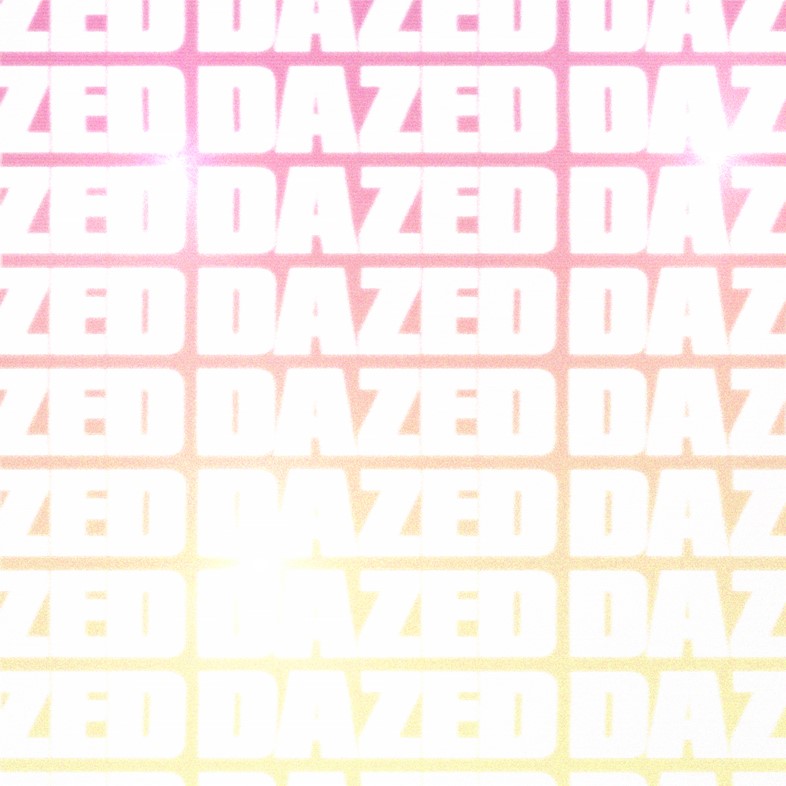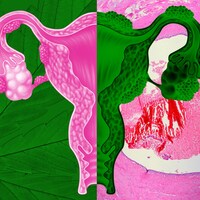From Bowie and Jagger in the 70s to Zendaya and Barbie Ferreira more recently, the shag haircut makes a rebellious statement in uncertain times
Scroll through Instagram and you’re likely to see someone sporting a version of the modern shag haircut. “New Hair. New Year. NEW MUSIC!,” is how Miley Cyrus captioned her one of first 2020 posts featuring her brand new blond shag, while the biggest models and celebs, Zendaya and Chloë Grace Moretz for example, have tried out their own versions. With long, thoughtful layers and a lived-in signature face-framing bangs, these cuts have quickly become an obsession for millennials who’ve made a conscious, stylistic choice to have long(ish) hair – something that may have felt near impossible before today’s shag cut took over Instagram.
The shag haircut’s journey to becoming the most Instagrammed cut of 2020 already began with the account of Jayne Matthews, of Edo Salon in San Francisco and Oakland, California. With over 77k Instagram followers, Matthews has garnered thousands upon thousands of likes and comments on her transformation photos of clients. She even hosts workshops teaching other stylists around the country how to create her signature shag cuts. All in all, the overall look of today’s shaggy haircut is definitively retro with an added edge of hippie, likely courtesy of Edo’s California roots. For the most part, the people getting the cuts are letting their natural texture run wild (curls, waves, etc) and they often have natural coloured hair, giving the style a much more organic, soft look, than perfectly blown-out straight hair without bangs.
“The best thing about the shag is how it can be tailored to each individual face. Bits kicking out right above the cheekbone make the eyes bigger. Height at the crown will make the neck look longer, and bangs... so many bangs to open up and frame the person’s best features,” explains Matthews of the style’s popularity. “But that’s not just it, there’s also the wearability factor. When it grows it just gets better over time. It changes from a more cool, late 60s vice to a breezy 70s boho girl vibe in eight months. I see many of my clients one time a year.
But the real origins of the classic shaggy haircut date back well before its renaissance in last year. Interestingly, it’s a hairstyle that has always had a link with counter culture, and many credit the invention of the shag haircut, as we know it, to a barber named Paul McGregor. In 1965, after working as a truck driver, longshoreman and sandhog, he came to the legendary St Mark’s Place, where the punk scene was just beginning and thriving, in New York City and opened his own salon. “He takes credit for inventing the shag, which he gave to Jane Fonda,” according to The New York Times. “She nearly fainted when she saw it. Once she realised she adored it, others came: Warren Beatty, Goldie Hawn, Faye Dunaway. When Warren Beatty made the film Shampoo about a hairdresser, many people said it was the story of Paul McGregor.”
Around the same time in Europe, a similar fascination with the shag haircut was taking place. French actress Brigitte Bardot, who starred in films from the mid-1950s through to the early 1970s was also known for her hair. Often worn up or in a bouffant, when it was down, the earthy, shaggy layers, wavy pieces and thick face-framing bangs resembled the early version of a shag haircut.
Often starring in boundary-breaking, provocative roles in French new wave films, such as Jean-Luc Godard's 1953 film Le Mépris, Bardot’s windswept, natural-looking shag haircut helped to visually emphasise her sex symbolism on-screen, After all, the flowing layers and messy shag cut was the exact opposite of the restrained ponytails and secured-with-hairspray bouffants of the 1950s.
“The best thing about the shag is how it can be tailored to each individual face. Bits kicking out right above the cheekbone make the eyes bigger. Height at the crown will make the neck look longer, and bangs... so many bangs to open up and frame the person’s best features” – Jayne Matthews, owner, Edo Salon
The shag cut really took off in the 1970s as rebellious rock stars of all genders made it their mainstay. Mick Jagger, Joan Jett, David Bowie, Rod Stewart, and David Cassidy among others all donned shaggy hair, most of it cropped to the shoulder with wide-angled bangs across the forehead. Jett and Jagger took things to new heights with smaller, spiker pieces cut around the crown of their heads, to add more texture to the soft and sexy shag haircut seen in the 1960s.
Male performers like Bowie and Jagger were also early proponents of gender-bending, using the shag haircut to push the boundaries of what new shapes and how long they could wear their hair. The latter of the two had a mother who was a hairdresser, which also may have played a role in the iconic, defining shag cut we know him best for. At the same time, the shag populated television during the 1970s – stylist Allen Edwards famously cropped the hair of the Charlie’s Angels stars (Farah Fawcett, Jaclyn Smith, and Kate Jackson) in shaggy cuts with upturned curls.
As the 1980s rolled around, many famous rock stars began growing their hair longer and longer, with less shaggy layers, and the decade was marked by a dedication to hairspray and big volume. However, the style would soon return in the 90s, and with a dedicated fan base like never before. It was all due to Jennifer Aniston, who famously played the role of Rachel on the American TV show Friends.
Aniston’s hair was cut into a shoulder-length, textured crop with plenty of face-framing pieces courtesy of Los Angeles-based stylist Chris McMillan. To put it simply, it was the haircut that went viral before things could go viral. Many dubbed it “The Rachel” due to the numerous requests salons were getting across the country to replicate it. According to the Encyclopedia of Hair: A Cultural History, it was the most popular haircut to sweep the US since the 1970s, when Farah Fawcett’s hair was an obsession. Despite this, all these years later, Aniston recently admitted that the “Rachel” cut was near impossible to style in real life.
Similarly, the hairstylist Sally Hershberger rose to fame in 1995 for cutting the actress Meg Ryan’s hair into a shorter, choppier version of the shag haircut for the film French Kiss. The trend continued heavily throughout the late 90s and into the 2000s when Jane Fonda also got her hair cut into a shaggy style by Hershberger, and Cyrus’ newly viral haircut is also her handiwork.
But why is the shag cut a thing again? It may have a lot to do with our nostalgia for the early 2000s and late 90s. Many of the early 2000s fashion trends have now made it back into our wardrobes – cargo pants, hair clips and monochromatic dressing are everywhere, albeit in their updated, more modern forms. Just like Edo Salon’s haircuts which are softer and a little bit more bohemian than their predecessors.
According to Anna McGuire, a fashion student, the shag haircut was the perfect solution for her hair when she was growing it out after having a shaved head. “I had a short, shaggy mullet, and just let it keep growing it out,” she explains. “I just wanted to look like a rockstar so I used Patti Smith as a reference and I’m really into Elton John at the moment – that free-spirited 70s thing is just a really nice place to be.” She also chose the style because it seems low-maintenance and cites Lady Gaga in A Star is Born as another inspiration.
“The look is screaming ‘enough Kardashian-contrived waves! Enough colours melting from ice blue to pale pink, to silver with perfect waves like a Barbie. We are ready to rock our natural beauty and see what it can do’” – Jayne Matthews, owner, Edo Salon
Shag haircuts aren’t just for long hair either. Take Karen Resta, who for example, has a sunflower yellow-hued short haircut. “It’s new, it’s chic and I’ve tried three different kinds of cuts the past few years. None of them did much for me in terms of making me look better,” she says of her newly introduced shaggy crop. “I saw shag cuts showing up on my Instagram feed and the before and after photos, and every single person looked great.”
Elsewhere, some people have been rocking the shag cut for nearly half a century. “I have sported this cut since the 70s. Much to my own entertainment and those around me, I am often mistaken for Rod Stewart,” explains R. Michael Givens. “There was a moment when my son was born in 1995 that I thought that I needed to change my look. It wasn’t long before I stopped recognising myself in the mirror. I made the all-important decision right then, that if I was stuck in the 70s, I was stuck in the 70s. It has become something of my trademark.”
The shag cut also relates to the overall trend of organic, all-natural beauty we’ve been seeing more and more of. Matthews herself calls her haircuts “non-toxic. Shags celebrate natural texture,” she explains. “It is truly effortless but also flattering in nature by the face-framing component of the style. The look is screaming ‘enough Kardashian-contrived waves! Enough colours melting from ice blue to pale pink, to silver with perfect waves like a Barbie. We are ready to rock our natural beauty and see what it can do’.”
It might also be an underlying subconscious reaction to politics around the world. Most people aren’t happy with politics in their home country, especially young people, and the shag haircut feels like a small way to rebel, simply by opting for a less generic hairstyle that has a strong connection to decades of rule-breakers: Bowie, Bardot, and Jagger. Today, the shag haircut continues to defy conventions.




